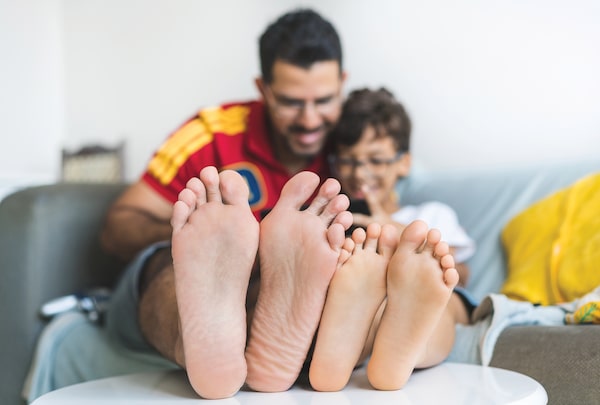
Diabetes can cause nerve damage (also known as diabetic peripheral neuropathy) and poor blood flow or circulation to the legs and feet (also known as peripheral arterial disease). As a result, people with diabetes are less likely to feel a foot injury, such as a blister or cut. Diabetes can make these injuries more difficult to heal. Unnoticed and untreated, even small foot injuries can quickly become infected, potentially leading to serious complications.iStockPhoto / Getty Images
By the time he was diagnosed with type 2 diabetes a decade ago, Donald Melanson had long had sore feet.
Before that diagnosis, the tingling, burning and numbness had been attributed to various conditions. The pain became so excruciating that the retired Toronto guest-services manager, who had previously been active and independent, was willing to try anything.
Then one day while doing some internet research, Mr. Melanson, 67, was filled with hope. He came across a link that led him to Dr. Asem Saleh, a vascular surgeon at Humber River Hospital who is part of a virtual network of health-care providers called Own Health that offers leading-edge comprehensive diabetes foot care.
In May of this year, Dr. Saleh operated on Mr. Melanson to open up clogged blood vessels in his lower legs and feet, and has conducted follow-up procedures to continue to treat his condition. The process is painful, but it’s bringing sensation to limbs he once feared might have to be amputated.
“I can feel my feet again and there’s colour in them; they’re not grey and purple,” Mr. Melanson says. “I haven’t been ticklish in years. Now let me tell you: don’t touch my feet.”
For Dr. Saleh, such cases are all too common in people with diabetes. His practice focuses on teaching people about the damage to nerves and arteries in the legs and feet that can come from high blood sugar levels. Demand for services has been consistently high since the practice opened, Dr. Saleh says.
He notes that many people with diabetes have nerve dysfunction and poor circulation in their feet, and some develop ulcers (15 to 25 per cent, according to Diabetes Canada); yet the issue is frequently ignored. Indeed, the training of vascular surgeons in Canada largely deals with larger blood vessels than those below the knees.
Blood sugar levels that are high over time can damage blood vessels. This can lead to loss of protective sensation and wounds that fester in an unaware patient, Dr. Saleh says. Toes, feet and entire legs considered “beyond salvage” are removed. He notes that foot problems can also be a warning sign of further issues with the hands, eyes and kidneys, because these problems suggest some damage may have occurred as a result of elevated blood sugar over a prolonged period.
Dr. Saleh and his colleagues have revamped the way that diabetic foot complications are looked after at Humber River and in the community. It’s a team approach that includes vascular, orthopedic and infectious-disease specialists, endocrinologists, podiatrists, plastic surgeons, nurse practitioners, dietitians and education specialists.
Tom Weisz, a retired chiropodist (foot specialist) in Hamilton, Ontario, who is a volunteer advocate with Diabetes Canada and has type 2 diabetes, says diabetic foot problems are occurring in part because health-care systems in Canada typically don’t invest in prevention efforts like routine foot care.
“It’s better to reduce a callous than to deal with a wound,” he comments, adding that there is growing awareness of diabetic foot problems, “but knowledge without action is meaningless.”
To prevent problems from developing in the first place, Mr. Weisz recommends that people with diabetes try to achieve and maintain their blood sugar targets, have their feet examined at least once a year by a professional and wear good shoes.
Mr. Melanson’s advice to people with diabetes and prediabetes is to check their feet every day and protect them with proper footwear, even in the house. His goal for December 1 is to be able to put on shoes and go for a walk.
Dr. Saleh says such cases point to the benefits of filling the “massive gap” in diabetic foot care. He hopes that governments in Canada will address the issue with greater efforts directed to patient foot care education, prevention, early diagnosis and treatment of smaller foot issues, more training for health-care professionals and widespread adoption of interdisciplinary models of care, which have been shown to help significantly in preserving limbs.
5 FOOT-CARE DON’TS
DON’T:
wear tight socks or stockings
warm your feet with hot water bottles or pads, which can easily lead to burns; instead, wear thick, not-too-tight socks – including in bed – to keep your feet toasty
go barefoot, even indoors
sit or cross your legs for long periods of time; instead, move around and wiggle your toes regularly throughout the day
smoke: it reduces circulation and healing, significantly raising the risk of amputation
For more information on managing your health, including foot care, visit diabetes.ca/resources.
Advertising feature produced by Randall Anthony Communications with Diabetes Canada. The Globe’s editorial department was not involved.